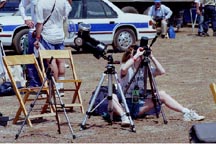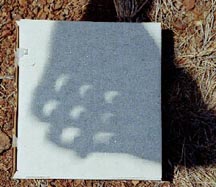|
Eclipse Day!
06:00 The first alarm went off. One of us turned it off.
06:15 The second alarm went off. This time one of us had to get out of bed to turn it off. The Sun hadn't risen yet, but the sky looked mostly clear with just a few cloudy patches.
07:45 We secured three cameras, three tripods, two lenses, a 4" telescope, 3 solar filters, 2 stop watches, a roll of tape, two 1.5 liter water bottles and a myriad of miscellaneous items on the bus, the first of two to leave the Princess Beach Resort. With the Sun up, and our humble observers much more awake, it turned out that the sky was mostly cloudy, with just a few patches of blue.
08:20 The bus left the other hotel, the Sonesta, after having picked up the members of the group staying there. The sky was totally overcast.

09:15 We arrived at the viewing site, and unloaded into a disoriented assembly.
There was a wind break wall of empty cargo containers with concession stands and tents set up. Another serious group had already arrived and set up their equipment. It wasn't clear where our group should set up camp, or whether the group would scatter across the field. Later we learned that a group of people stayed overnight and were none too excited when it rained at 04:30. While there were some blue patches, there were also some very large dark clouds rolling in, the sort of clouds that like to dump rain on tourists. We were told this is normal and usually clears up by noon. Usually.
We established our turf near the other group of serious folks, but some others in the group found a better location on the other side of the cleared area, so we headed over there. It was not a good omen that the only way we knew how to orient things was that we remembered how the stars lined up over the container wall from the night viewing on Monday.
11:00 The clouds have broken! The Sun rose up well above the few remaining clouds, and it seemed pretty certain that nothing was going to get in the way.

12:00 By noon, we had spent an hour baking in the Sun, pretty certain that we would be in for a good show. The local government, working on the advice of the tour group (and presumably with their funding) had gone all out to make sure this was a great experience for everyone. There were tents for shade, cold drinks, free bottled water, restroom facilities, a couple of ambulances, several fire engines, and water trucks spraying to keep the dust and temperature down. We were blown away when we found that they had rented folding tables and chairs for us to use, this was a much better solution that sitting or kneeling on the rocks. After a while, the supply of chairs ran out, and it looked like chairs would become a highly coveted commodity, but then a truck showed up with another load.
There were multiple TV crews, including the local channel 8, which reportedly was feeding directly to CNN. There was a guy (perhaps a BBC reporter) wandering around doing tape interviews, and some flamboyant gray-haired French dude repeatedly wandering through our group and reciting an eclipse lecture in front of TV cameras. We had decided to wait to set up the cameras and the telescope until around noon, just to minimize the time they have to spend in the wind, dust and heat. Just as we were about to set up, lunch arrived in a semi-truck and a huge line formed to exchange our little tickets for lunch boxes.

12:25 Tom worked his way to the front of the lunch line and scurried back to eat lunch. Cathy had her stuff all set up and wasn't hungry, or at least wouldn't admit it.

12:40 With everything all set up, Cathy watched the Sun through a 500mm camera lens and Tom through the telescope, with proper solar filters attached. At about the predicted time, members of the crowd started shouting, and at 12:41:57 Tom noticed (and Cathy dutifully recorded) that a bit of the east-facing perimeter of the Sun was ever so slightly flattened. A few seconds later Cathy could see the subtle start of a dent in the Sun. The partial phase of the eclipse had begun.
We were lucky to have two groups of Sun spots visible, in two pairs with smaller spots around the four larger spots. As the Moon crept into the Sun, its subtly jagged edge became more and more visible. Within twenty minutes there was enough of the Moon's perimeter visible to see one very clear mountain and adjacent valley. It was very small in the eyepiece, but quite clear and amazing to see such a detail from 240,000 miles away.
The heat was bearable, but only because the wind kept us cool. Although we had 90 minutes to wait for the Moon to cover the entire face of the Sun, the time passed quickly. We were both watching directly through filters, and through our respective lenses. Cathy took photos at regular intervals, and Tom swapped between having an eyepiece and a camera on the telescope, occasionally talking Cathy into leaving her camera to see a clearer image through the eyepiece on the telescope.

13:25 The visible sunspots were obstructed and the leading edge of the Moon had reached the center of the Sun's disc. We had made it half way through the first partial phase, moving quickly to totality. Around this time, we were able to see the crescent shape of the Sun on the ground by making a very crude pin-hole lens just by lacing our fingers into a grid. A woman behind us had been crocheting and created hundreds of little Sun crescents on the ground by holding her handiwork above a blanket.
13:40 At about a half hour from totality, the Moon was two thirds of the way across the Sun. Someone nearby mentioned that it was cooler, and it really was. According to a thermometer, it was only a degree cooler, but it felt like more, probably because the temperature had stopped its quick ascent.
13:50 We were twenty minutes away from totality, but the Sun was still far too bright to look at directly. Through the filters, it was a quickly waning crescent, and Tom realized that he no longer needed his sunglasses. Not having to fumble with sunglasses made the procedure of swapping the camera and the eyepiece somewhat less complex.
14:09 People had been talking about Venus for a few minutes, and we finally found it clearly visible. It was about half way between the Sun and the horizon and was shining very brightly -- in the middle of the afternoon.
14:10 Now just 90 seconds from totality, we took the solar filters off of our lenses. It was still not safe to look at the Sun without the filters; even the thinnest crescent of the Sun's surface is literally blindingly bright.
14:11:26 (Or so. We were too busy to look at the time.) Looking through the handheld solar filters, we watched as the Sun's crescent shortened and disappeared. We had seen many pictures of totality, and completely understand it conceptually, but were still unprepared for what happened next. The Sun disappeared through the solar filters, and when we dropped the filter to look directly at the Sun, there was suddenly a black disc covering the Sun. Around its perimeter, the Sun's chromosphere was a burning ring in the sky. Nearby, within a few solar diameters, Mercury and Jupiter were clearly visible, along with Venus, making for three "stars" visible in mid day. It was light enough to see by, but Tom had turned on the flashlight clipped to his shirt, and it was actually helpful reading his watch.

Moving quickly back to our lenses to see a magnified view, we were stunned to see the things we had read about. The Sun's corona faded from a bright ring to a wide wispy structure spreading out side-to-side. Inside the bright white ring, we could see flares of orange gas erupting from the Sun's surface and clearing the Moon's obstruction.
In what seemed like a few seconds, the first minute of totality passed. Tom switched to the third camera to try for a wider angle photograph of the Sun with the two closer planets and Cathy got her minute through the telescope's eyepiece. Cathy then switched back to her camera and Tom quickly removed the eyepiece and reattached his camera to the telescope in hopes of getting some photos of the Sun coming out of totality. Tom barely made the switch in time, isn't sure if he snapped any photos during totality and neglected to switch to a faster shutter speed in time for the reemergence of the Sun's surface.
14:15 Fortunately, we had heeded the advice of the seasoned veterans and put observing the eclipse as a higher priority than photographing it, and we both got a good look. Three and a half minutes passed unimaginably quickly. There were several effects we missed entirely, but we saw what we thought was most important. We now understand why people make a habit of chasing eclipses: it's not just that it's an amazing phenomenon, but also that there are so many beautiful and fascinating aspects that it's impossible to experience them all in one very brief viewing. Maybe next tune we'll remember to look at the horizon for the 360 degree sunset colors, watch for the Moon's shadow racing across the Earth, or look for the patterns of light and shadow caused by turbulence in the atmosphere just before and after totality.
Once people had recovered from the shock of what had just happened, champaign corks popped, toasts, smiles and hugs were exchanged. For the tour organizers, this had been a two-year odyssey, starting with a scouting trip to Curaçao in March 1996. Everyone is pleased with a perfect eclipse, but none more so than those who planned the experience for the rest of us.
As the toasts finished up, the group gathered for a barrage of group photos. One creative photographer backed up a bit to get the photo of the group behind the six tripods holding cameras with self timers recording the event.
Many people started packing up, but some were still intently viewing and recording the event. The trailing edge of the Moon became visible in profile as the Moon continued to pass over the Sun, slowly uncovering the surface. There was a different distinct mountain visible on this edge. Within 30 minutes or so, the two groups of sunspots were once again visible. Soon, sunglasses were needed and the temperature was back on the rise. We managed to disassemble everything and get loaded just as the first bus was leaving. The second bus had to wait until the last die-hard astrophotographer has recorded the Sun's final escape from behind the Moon. We enjoyed the final minutes of the partial eclipse phase from the bus (ending at 15:36 by our observation) as we headed back to our hotel for showers and dinner.
That evening, after cleaning up and relaxing for a bit, we joined the rest of the group for dinner. We met a nice couple from Illinois, Larry and Suzanne. He had seen an eclipse 20-some years ago; this was her first. It was great to go over everything that we had seen and done. It was comforting to learn that everyone had been stunned at the spectacle and had failed to do everything they set out to do during the too brief total solar eclipse.
Back to Main Eclipse Page.
|
©1996-2025 Tom and Cathy Saxton. You may not copy or reproduce any content from this site without our consent.